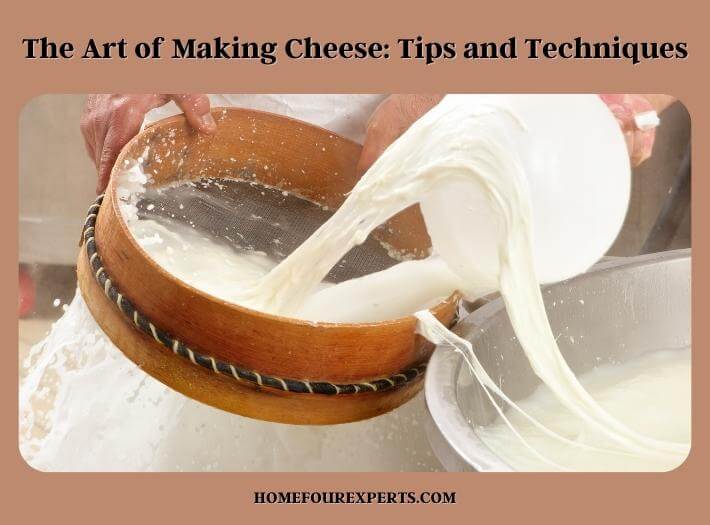Published on: March 13, 2023
Written by Eric Devin / Fact-checked by David Rowan
Making cheese is a skill that has been practiced for thousands of years, and it is an art form that has been perfected by many cultures around the world. While it may seem daunting to make your own cheese at home, with the right techniques and equipment, it is a surprisingly simple process.

Not only can make your own cheese be a fun and rewarding hobby, but it can also lead to a deeper appreciation for the nuances of cheese flavors and textures.
The Basics of Cheese Making
Cheese-making is a fascinating process that involves transforming milk into a solid, flavorful product through a series of carefully controlled steps. While there are many different types of cheese, the basic principles of cheese-making are the same.
Milk Selection
The first step in cheese making is to select high-quality milk. Ideally, this should be fresh, raw milk from a local dairy. However, pasteurized milk from the grocery store can also be used. The fat content of the milk will affect the final product, with higher fat content producing a creamier cheese.
Acidification
In order to coagulate the milk and create curds, an acid must be added. This can be in the form of lemon juice, vinegar, or a starter culture. The type of acid used will affect the flavor and texture of the cheese.
Coagulation
Once the acid is added, the milk will begin to coagulate into curds. This can take anywhere from a few minutes to several hours, depending on the type of acid used and the temperature of the milk.
Curd Cutting
Once the curds have formed, they must be cut into small pieces in order to release the whey. The size of the curds will affect the texture of the final cheese.
Whey Drainage
The whey is then drained off, leaving the curds behind. The curds can be further drained and pressed to create a harder cheese, or they can be left moist for a softer cheese.
Salting
Salt is then added to the curds to flavor the cheese and aid in preservation. The amount of salt used will depend on the type of cheese being made.
Aging
Finally, the cheese is aged for a period of time to allow the flavors to develop and mature. The length of aging time will vary depending on the type of cheese.
How to Choose the Right Milk?
When it comes to making cheese, the type of milk you choose will have a significant impact on the final product. Here are some tips for selecting the right milk for your cheese-making:

- The fresher the milk, the better the cheese. Look for milk that has been minimally processed and has not been sitting on the shelf for an extended period of time.
- Content The fat content of the milk will affect the texture and flavor of the cheese. Whole milk contains around 3.5% fat, while skim milk has virtually no fat. For a creamier, richer cheese, choose milk with higher fat content.
- The source of the milk can also affect the flavor of the cheese. Raw milk from a local dairy can provide unique flavors and characteristics to your cheese, while store-bought milk may have a more generic taste.
- Different types of milk can be used to create different types of cheese. Cow’s milk is the most commonly used, but goat and sheep milk can also be used for certain types of cheese.
- Many cheese makers prefer to use raw milk, as it contains natural bacteria and enzymes that can enhance the flavor and texture of the cheese. However, raw milk can also contain harmful bacteria, so it is important to handle it carefully and follow proper sanitation practices. Pasteurized milk can also be used, but may require the addition of a starter culture to achieve the desired flavor and texture.
Types of Cheese
Cheese comes in many different varieties, each with its own unique flavor, texture, and aroma. Here are some of the most common types of cheese:
- Cheddar: known for its sharp, tangy flavor; a hard cheese that can be aged for several years
- Mozzarella: a soft, fresh cheese often used in Italian cuisine; mild, creamy flavor and stringy texture when melted
- Parmesan: hard, aged cheese commonly grated over pasta dishes; nutty, salty flavor and granular texture
- Brie: soft cheese characterized by its creamy texture and mild, buttery flavor; often served with crackers or bread
- Blue Cheese: pungent cheese with blue or green veins; strong, tangy flavor and creamy texture
- Swiss: firm cheese characterized by its distinctive holes; mild, nutty flavor and slightly rubbery texture
- Feta: crumbly, salty cheese often used in Greek cuisine; tangy flavor and slightly grainy texture
- Gouda: semi-hard cheese known for its smooth, buttery flavor; can be aged for several years to develop a stronger flavor
- Provolone: firm cheese often used in Italian sandwiches and pizzas; mild, slightly sweet flavor and smooth texture

This is just a small selection of the many types of cheese available. Each type has its own unique flavor, texture, and characteristics, making them versatile ingredients in many different types of cuisine.
Tips for Successful Cheese Making
Making cheese at home can be a rewarding and enjoyable experience. Here are some tips for successful cheese-making:
- The quality of your cheese will depend on the quality of the milk you use. Choose fresh, high-quality milk that has not been pasteurized at high temperatures.
- The temperature of the milk is important for the success of your cheese-making. Make sure you maintain the proper temperature for each step of the process.
- Cleanliness is crucial when making cheese. Make sure all of your equipment is properly sanitized to prevent the growth of harmful bacteria.
- Rennet and starter culture are essential ingredients in cheese making. Be sure to use the correct amount of each ingredient to ensure a successful batch of cheese.
- Cheese making can be a delicate process, so it’s important to follow the recipe closely. Don’t make any substitutions or changes unless you’re experienced in cheese making and know how it will affect the final product.
- Cheese-making requires patience, as it can take several hours or even days to complete the process. Don’t rush the process, as this can result in poor-quality cheese.
- Small details can make a big difference in the quality of your cheese. Pay attention to every step of the process and make adjustments as needed.
FAQs
How Long Does Homemade Cheese Last?
The shelf life of homemade cheese can vary depending on the type of cheese and how it’s stored. Soft cheeses like ricotta and feta have a shorter shelf life than harder cheeses like cheddar and parmesan. Generally, homemade cheese should be consumed within a few weeks to ensure freshness and quality.
Can I Make Cheese at Home Without Any Special Equipment?
It’s possible to make cheese at home without any special equipment, but it’s recommended to have a few basic tools like a thermometer, cheesecloth, and a cheese press. These tools can help ensure the quality and success of your cheese-making.
Can I Make Cheese Without a Cheese Press?
Yes, you can make some types of cheese without a cheese press. Soft cheeses like ricotta and cream cheese can be made without a press, while harder cheeses require a press to shape and compact the curds.
Is It Necessary to Use Raw Milk for Cheese Making?
No, it is not necessary to use raw milk. Pasteurized milk can also be used, but it’s important to make sure it hasn’t been pasteurized at high temperatures, as this can affect the quality of the cheese.
How Long Does It Take to Make Cheese?
The time it takes to make cheese can vary depending on the type of cheese and the recipe you’re using. Some cheeses can be made in a few hours, while others require several days or even weeks to mature.
If you want to create your own jewelry, see here for the process.
About This Writer

Hi, I am Eric Devin and I am a professional interior architect. Since childhood, I've always enjoyed DIY projects! And, I have loved to solve simple household problems using essential tools and equipment. I have also acquired a lot of information about basic household tools settings by working with contractors.